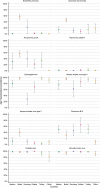Seroprevalences of antibodies against ToRCH infectious pathogens in women of childbearing age residing in Brazil, Mexico, Germany, Poland, Turkey and China
- PMID: 33124529
- PMCID: PMC7689786
- DOI: 10.1017/S0950268820002629
Seroprevalences of antibodies against ToRCH infectious pathogens in women of childbearing age residing in Brazil, Mexico, Germany, Poland, Turkey and China
Abstract
Determination of antibodies against ToRCH antigens at the beginning of pregnancy allows assessment of both the maternal immune status and the risks to an adverse pregnancy outcome. Age-standardised seroprevalences were determined in sera from 1009 women of childbearing age residing in Mexico, Brazil, Germany, Poland, Turkey or China using a multiparametric immunoblot containing antigen substrates for antibodies against Toxoplasma gondii, rubella virus, cytomegalovirus (CMV), herpes simplex viruses (HSV-1, HSV-2), Bordetella pertussis, Chlamydia trachomatis, parvovirus B19, Treponema pallidum and varicella zoster virus (VZV). Seroprevalences for antibodies against HSV-1 were >90% in samples from Brazil and Turkey, whereas the other four countries showed lower mean age-adjusted seroprevalences (range: 62.5-87.9%). Samples from Brazilian women showed elevated seroprevalences of antibodies against HSV-2 (40.1%), C. trachomatis (46.8%) and B. pertussis (56.6%) compared to the other five countries. Seroprevalences of anti-T. gondii antibodies (0.5%) and anti-parvovirus B19 antibodies (7.5%) were low in samples from Chinese women, compared to the other five countries. Samples from German women revealed a low age-standardised seroprevalence of anti-CMV antibodies (28.8%) compared to the other five countries. These global differences in immune status of women in childbearing age advocate country-specific prophylaxis strategies to avoid infection with ToRCH pathogens.
Keywords: Antibodies; ToRCH; congenital infections; diagnostics; immune status; immunoblot; maternal infection; pregnancy; serology; seroprevalence.
Conflict of interest statement
JMW, MP, VBL, JJ, AO, TS and WM are employees of EUROIMMUN Medizinische Labordiagnostika AG, Luebeck, Germany. WL and FL are employees of EUROIMMUN Medical Diagnostics China Co., Ltd., Beijing, China. KB is employed by EUROIMMUN Polska Sp. z.o.o., Wroclaw, Poland. EG is employed by INOCHEM, Mexico City, Mexico. None of the authors benefits from any potential or actual financial or non-financial gain as a result of the work.
Figures


References
-
- De Jong EP et al. (2013) How to use…neonatal TORCH testing. Archives of Disease in Childhood: Education and Practice Edition 98, 93–98. - PubMed
-
- Rasti S et al. (2016) ToRCH ‘co-infections’ are associated with increased risk of abortion in pregnant women. Congenital Anomalies 56, 73–78. - PubMed
-
- Ostrander B and Bale JF (2019) Congenital and perinatal infections In de Vries LS and Glass HC (eds), Neonatal Neurology. Amsterdam, the Netherlands: ELSEVIER, pp. 133–153. - PubMed
-
- Batra P, Batra M and Singh S (2020) Epidemiology of TORCH infections and understanding the serology in their diagnosis. Journal of Fetal Medicine 7, 25–29.
MeSH terms
Substances
LinkOut - more resources
Full Text Sources
Medical

